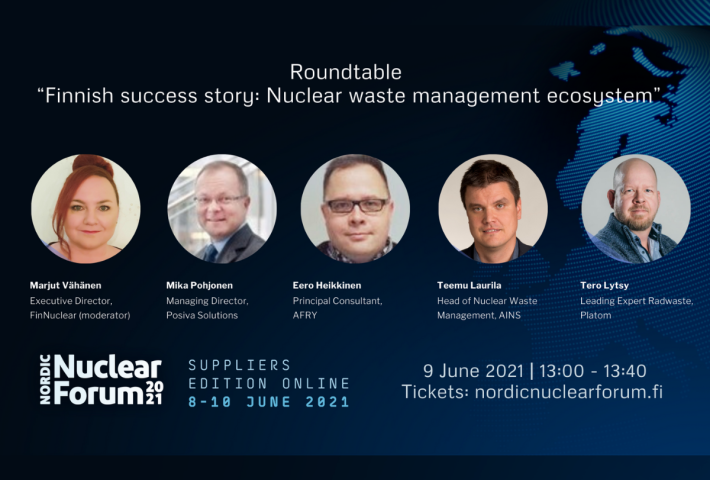
Attend Nordic Nuclear Forum 2021 to hear about the stories and experiences of a few companies who have been part of the journey to implement the Finnish success story.

At the moment, Finland is the world’s leading country in the final disposal of spent nuclear fuel. In Finland Posiva has constructed the underground rock characterization facility (ONKALO®), which will be part of the final repository for spent nuclear fuel currently under construction. The disposal design is based on KBS-3 concept (originally developed by the Swedish SKB), where spent fuel is encapsulated in metal canisters surrounded by bentonite clay and emplaced at a depth of several hundreds of metres. All access routes from the surface to the disposal tunnels are backfilled and sealed.
The successful story of Finnish nuclear waste management is due to an extensive research, development and design work over the decades done by Posiva and its network of suppliers and contractors, as well as research institutions. The whole project has been a long journey containing several milestones, as the following short historical overview shows.
Nuclear waste management policy dates back decades, in fact to the 1980s, when they were defined by the Finnish government in 1983. The Ministry of Trade and Industry revised the nuclear energy legislation in 1987 defining the principles and time schedules for nuclear waste management. The policies gave the basis for the practical implementation of nuclear waste management and the research and development related to a spent nuclear fuel disposal.
Responsibility for the entire lifecycle of nuclear power goes hand in hand with long-term commitment, beyond the end of nuclear power plant operation until taking care of all waste generated during the use of nuclear energy and decommissioning of the plants, as well as disposal of spent nuclear fuel.
Since 1983 the information on geology and the technology related to final disposal have been gathered by TVO. According to a review of the existing geological data, there could be over a hundred sites suitable for final disposal in Finland. However, the procedure in the Nuclear Energy Act guaranteed that municipalities have veto right over the construction of any nuclear facility. Taking this into account as well, five of all suitable sites were selected for preliminary site surveys conducted in 1987–1992 and further on, three of these were selected for detailed site surveys.
Also Loviisa, where Fortum’s (former IVO) nuclear power plants exist, became the fourth candidate site because it was no longer possible to export nuclear waste according to the amendment that was made to the Nuclear Energy Act in 1994. (i.e. Nuclear waste generated as a result of the use of nuclear energy in Finland shall be handled, stored and permanently disposed of in Finland). In 1995 this led TVO and Fortum to establish Posiva Oy whose purpose is to take care of the disposal of the spent nuclear fuel of its owners and communicate with the authorities as well as acquire the required licenses for the facilities it constructs and operates. Following the detailed site surveys from 1993 to 1999, Eurajoki municipality was chosen for the repository site in 2000.
STUK, the Finnish Radiation and Nuclear Safety Authority, is responsible for the control and supervision of activities involving radiation. Respectively, the construction and operation licenses for nuclear facilities are granted by the Government but, before actual licensing can take place, a policy decision called the Decision-in-Principle (DiP), which states that the construction of the facility is in line with the overall good of society, needs to be approved by the Parliament. In 2000 the Government issued DiP on the disposal of spent nuclear fuel, and in 2002 it was extended to concern the spent fuel from the Olkiluoto 3 plant unit.
Posiva began construction of an underground research facility in 2004 ONKALO® at Olkiluoto site. In 2012, Posiva submitted to the Government the application for the construction of the disposal facility and in 2015 Posiva received the world’s first construction licence for a geological disposal facility with the Government’s approval. The next important milestone is to submit an operating licence application. The final disposal will begin in the mid-2020s and it will continue for about 100 years.
Finland has proceeded systematically and carefully with its waste management programme and it has been a joint effort from many actors. The work is still going on and it will provide business opportunities and competence development for many companies.




